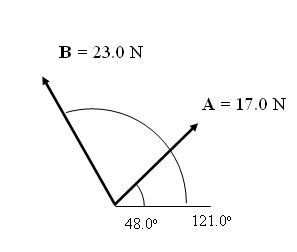PreQuiz 9.1 .:. Go Up
Statics
Show your work, and circle your answers and use sig figs to receive full credit. Use g = 9.81 N/kg
1. Find the Equilibrant Ė express it as an angle magnitude vector.† Draw it with its tail on the origin.† Write your answer with 3 sig figs, but carry at least 5 so you donít make rounding errors. (32.4 N, 89.2o CW from x axis)
|
|
x |
y |
|
A |
|
|
|
B |
|
|
|
E |
|
|

Solution:
First - find the components of the vectors. This is easy here because I give you the Trig angle:
Ax = (17.0 N)cos(48o) = 11.375 N
Ay = (17.0 N)sin(48o) = 12.633 N
Bx = (17.0 N)cos(48o) = -11.846 N
By = (17.0 N)sin(48o) = 19.715 N
(Remember - if you have the trig angle, cos gives you the x component always, and sin the y - notice that these components make sense - B would have a negative x component because is to the left of the y axis)
Next - put these in the table and add them together - x to x and y to y:
x y A 11.375 N 12.633 N B -11.846 N 19.715 N Sum -0.471 N +32.348 N Equil +0.471 N -32.348 N The equilibrant is just negative the sum (i.e. it adds to the others to make zero...)
Now you have to draw the equilibrant:
The Equilibrant is the hypotenuse - the angle indicated is the tan-1(32.348 /0.471) = 89.2o
and the hypotenuse = sqrt(32.3482 + 0.4712) = 32.351 N = 32.4 N
Question 1 is to see if you can find an equilibrant
2. Find the tensions in the cables C and D.† Set up your x and y equations where indicated, and if you set up a matrix, write down what you are entering into it in matrix notation. (C = 192 N, D = 285 N)

Question 2 is a force equilibrium solvable with a matrix
X:
Y:
